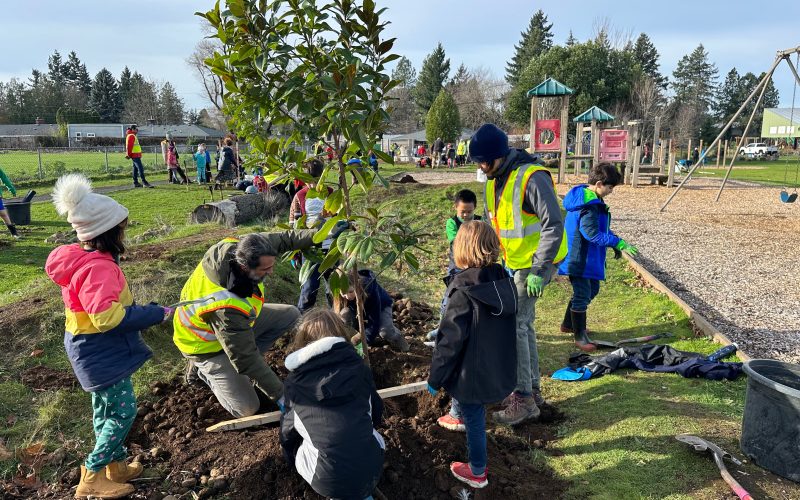In order to alleviate the financial burden on locals, Portland plans to plant 660,000 trees over the next 40 years and start a citywide, city-managed street tree upkeep program.
According to a draft of the new Urban Forest Plan, the need to preserve, repair, and grow the city’s trees and vegetation is being driven by the recent loss in the forest canopy, an imbalance in the amount of tree cover around the city, and the rise in extreme weather events.
By 2065, the proposed plan aims to increase the amount of tree cover in the entire city to 45%. 10,700 additional acres of canopy or 660,000 trees—nearly one tree for every Portlander—will be needed to achieve that.
Approximately one-third of Portland’s land area, or 27,600 acres, is covered with 4.2 million trees.
According to city officials, trees are essential for livability because they offer shade and access to nature during hot weather, as well as purifying the air and lowering carbon dioxide levels.
The proposal is an update of a 2004 plan that was created by the city with public participation and made available for comment this week. It would be financed by over $100 million from Portland’s Clean Energy Fund in addition to other financing sources.
Every community must have at least 25% of its area covered with trees. Just under half of the city’s neighborhoods have accomplished that as of right now.
Downtown and the region along to the Columbia and Willamette rivers have the least amount of trees.
However, the largest effort will be to increase the number of trees planted in Portland’s residential districts, particularly on the far east side where many people of color reside and incomes are lower.
The objective is to increase the outer east side tree canopy from 27% to 50%. Approximately 26% of the inner east side’s neighborhoods are covered with trees, and 45% canopy is the target.
In neighborhoods known for having poor canopy and a higher percentage of low-income residents, the city gives priority to planting trees. This aids in expanding fair access to the advantages that trees offer, said Mark Ross, a spokesman for Portland Parks & Recreation.
The city has no plans to increase the canopy on the west side, which contains Forest Park, which currently has a 66% cover.
Parks & Recreation in Portland
Additionally, the city intends to take up the planting and upkeep of street trees. Trees placed along sidewalks, roadways, and in the gaps between curbs are known as street trees.
According to municipal officials, the fact that residents are now in charge of maintaining the trees adjacent to their homes deters people from planting street trees because it is expensive, time-consuming, and a financial burden, particularly for Portlanders with lower incomes.
Portland Parks & Recreation launched a roadway maintenance program last year with $65 million from the Portland Clean Energy Community Benefits Fund, a climate fund that was started by a 1% tax on the city’s major businesses.
According to bureau officials, creating and implementing a pilot program will take five years.
A five- to ten-year management cycle comprising inspection, pruning, hazard abatement, removal, and replacement if necessary will be implemented for all 240,000 street trees in the city.
Tens of thousands of new street trees will be planted thanks to the funding, which will also eventually replace an estimated 76,000 trees that are too small for their locations.
The draft plan states that Portland wants to raise the street tree canopy from the current 24% to at least 35% during the next 20 years.
A large portion of the city’s tree planting initiatives will also be funded by the Clean Energy Fund, which has been awash with surplus income in recent years.
Parks & Recreation has been given $40 million over five years by the fund to plant and grow a minimum of 15,000 trees on both public and private property. The initiative will not only plant trees but also monitor their health and provide locals with materials for tree care.
The fund provided an additional $5 million over five years to the Parks Bureau to help low-income property owners maintain their current private property trees.
Additionally, it was given $35 million to support the current arborists, tree inspectors, and employees who look after trees in parks and public areas. Additionally, it was given money to subsidize some tree care on private property and lower the cost of tree management by lowering or doing away with the costs associated with applying for and inspecting tree permits. Additionally, it received about $2 million for the creation of contractors and a personnel for the planting and upkeep of trees.
Additionally, $5 million was awarded to the Portland Bureau of Transportation for the 82nd Avenue street tree expansion initiative, which will provide 2,500 feet of sidewalk along 82nd Avenue with space for medium and big trees.
According to Ross, the city will also implement the Urban Forest Plan’s recommendations using funds from the general fund, Portland parks levy, and the Title 11 Tree Planting & Preservation Fund.
Through direct planting in parks, schools, restoration sites, and natural places, as well as free street tree planting and tree distribution for residents to plant in their own yards, the city has gradually increased planting in priority neighborhoods since 2019. The city and its partners planted or distributed 11,000 trees during the 2024 planting season. In 2022, there were over 10,000 trees, and in 2023, there were almost 8,000 trees.
Residents have until April 13 to provide input on the draft plan.
Gosia Wozniacka discusses a variety of environmental topics, including climate change, environmental justice, and the switch to sustainable energy. You may contact her at 971-421-3154 or [email protected].
Your support is essential to our journalism. Sign up for OregonLive.com now.










